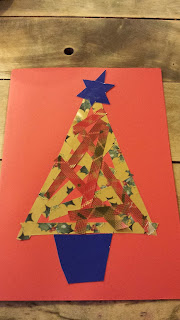“Anyone who writes down to children is simply wasting his time. You have to write up, not down. Children are demanding. They are the most attentive, curious, eager, observant, sensitive, quick, and generally congenial readers on earth. They accept, almost without question, anything you present them with, as long as it is presented honestly, fearlessly, and clearly. “ E.B. White
This gives children their due. Children are often told to do this and be that and have all natural joy shaped and moulded into the ways others want them to be yet in a heartbeat they can spring back to an apparently boundless natural optimism and creativity with a speed and resilience not generally matched by adults.
Recently I went to help six or seven year olds with Chrismas crafts at our school. On the table allocated to me the teacher had prepared an example of a Christmas card with a Christmas tree design and the material to make it. Here is a similar version.
To make the cards, there was a triangular template made from card, Christmas wrapping paper, pre-cut into strips, glue and scissors. At the table there were spaces for six children at a time. When they had finished they rotated on to tables with other activities. Few children asked what they had to do. Most, must have, I suppose, glanced at the card but plunged straight in. A few hesitated for a moment, looking to me for guidance. “Guidance” it turned out just meant in most cases, showing them where to start by pointing out the pile of coloured card so that they could choose from the selection, and sometimes passing them the tree template.
The lovely thing was that nobody just copied the example card. Some made their strips all one way. Some used the card to cut out other pieces of card to make tree decorations. Somebody decided to make a border to their card using these strips, someone else decided to use a spare cut-out star to decorate their tree’s pot, someone asked how to curl the paper like ribbon to make curly decorations for their tree like this..
All the children's cards were very creative and completely individual. Sometimes, one of the ideas would live for a bit among the other children. For a while a few people did borders, then there was a ribbon curling phase. I loved how the ideas appeared and were shared, lived for a while and gave way to others.
Everyone completed a card with little assistance, more a sense of support, of being, as Tango Commuter put it recently “pointed in the right direction”. One boy folded his card the “wrong” way and like one or two other boys seemed generally hesitant and so uncertain I thought he was going to struggle with many things. In fact no. We just made his card into a unique, tall card, he took his time and was happy with the result. In this expressive activity there were no “mistakes”.
How these children learned seemed to me so different to the overthinking that happens when adults are taught improvised social dancing in class. Simple Scottish country dancing of the kind danced in ceilidhs is different because it is a series of sequences though I and most have learnt them socially. But Argentine tango and also swing - from the little of it I have danced - is improvised and best learnt socially by dancing with experienced people as it used to be. In fact, I danced swing (of a sort) with my elder son yesterday in the kitchen and was delighted when he, who dances tango, immediately initiated entirely different swing sorts of movements that he had not seen from me.
In the craft classroom the children obviously were not paying anyone or expecting anything in return. The children were as focused as you see adults in dance class, but only because it is a natural state for them, not one caused by intent on an ROI. The children were relaxed and natural and happy, brimming with creativity and experimentation, like my son when he dances who has never been to tango or swing dance class; like most children in fact and some untrained adults when they feel moved to dance.
 |
| Local cafe |
It was the same later in the week at the school Christmas concert which for me is when Christmas really feels like it begins. Each class sang two Christmas songs. There were traditional songs and party songs. It was the variety that I enjoyed. The ones that were nicest to watch were those where you could see those same qualities I felt in the craft class - the ones where the children were most happy, having fun and relaxed. These tended to be the younger classes. Even within the cohesion required for group song you could see the individuality expressed in the children’s faces, their Christmas clothes, the instrumental moments in the songs when they all danced - in all the ways in fact in which they expressed themselves.
In craft class, a cd was playing. The children spontaneously burst into favourite Christmas songs. How they were in themselves directly affected what they made. They did copy an example, but it was only an example - a basis for their own ideas. There was no forcing it on them, no exactitude, no repetition, no oppression, no right, no wrong. The cards were all individual, very loose interpretations of the example and all the better for it.






